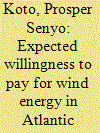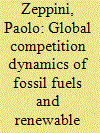|
|
|
Sort Order |
|
|
|
Items / Page
|
|
|
|
|
|
|
| Srl | Item |
| 1 |
ID:
150926


|
|
|
|
|
| Summary/Abstract |
Existing policies of household biogas projects focus mainly on supports on construction, but less consider management and maintenance, resulting in high scrap rate and waste of resources. Alternative policies must be explored to balance construction and operation. Taking the costs and benefits from a typical rural household biogas project, this paper assesses the economic performance at three different subsidy levels, i.e., no subsidy, existing standard and positive externality based standard. Furthermore three subsidy alternatives, one-time, annual and combined option are applied to the externality based standard. The results show that household biogas digesters have unsatisfactory economic performance without any subsidy and even in current subsidy policies. Environmental benefits of the digester were estimated as 2732 Chinese Yuan, significantly larger than existing subsidy standard. To keep continuous work during the 20-year lifespans of digesters, the income disparity of farmers among regions must be considered for policy application. With the increasing of labor costs, the ratio of initial subsidies must be reduced. These results provide policy implications to the future development of biogas projects in terms of both their construction and follow-up management, reuse of the abandoned digesters as well as the exploitation of other emerging renewable energy projects.
|
|
|
|
|
|
|
|
|
|
|
|
|
|
|
|
| 2 |
ID:
193752


|
|
|
|
|
| Summary/Abstract |
We examine the impact of proximity to land-based commercial wind turbines on residential home values in the United States using data on the universe of commercial wind turbines and residential property transactions from 2005 to 2020. Using event study and difference-in-differences identification strategies we find that, on average, homes located within 1 mile of a commercial wind turbine experience approximately an 11% decline in value following the announcement of a new commercial wind energy project, relative to counterfactual homes located 3 to 5 miles away. Event study estimates also reveal important dynamics in the evolution of home values, with property values first declining following project announcement, and then recovering post project construction, with property value impacts becoming relatively small (∼2%) and statistically insignificant 9 years or more after project announcement (roughly 5 years after operation began). Homes located within 1–2 miles of a commercial wind turbine experience much smaller impacts and homes located farther than 2 miles away are unaffected. Our results are primarily driven by wind projects located in urban counties with populations greater than 250,000.
|
|
|
|
|
|
|
|
|
|
|
|
|
|
|
|
| 3 |
ID:
181796


|
|
|
|
|
| Summary/Abstract |
By 2030, Austria aims to meet 100% of its electricity demand from domestic renewable sources, such as wind energy. Apart from the benefit of reducing CO2 emissions and, potentially, system cost, wind power is also associated with negative impacts at the local level, particularly its interference with landscape aesthetics. Some of these negative impacts might be avoided by using alternative renewable energy technologies. To better understand the trade-offs involved, we quantify the opportunity cost of wind power versus its best feasible alternative, which is solar photovoltaics in Austria. Methodologically, our analysis relies on the power system model medea, a technology-rich, partial-equilibrium model of the Austro-German electricity and district heating markets. Our findings suggest that the cost of undisturbed landscapes is considerable, even more so when solar PV is mainly realised on rooftops. Under a wide range of assumptions, the opportunity cost of wind power is high enough to allow for significant compensation of the ones affected by local, negative wind turbine externalities.
|
|
|
|
|
|
|
|
|
|
|
|
|
|
|
|
| 4 |
ID:
092855


|
|
|
|
|
| Publication |
2009.
|
| Summary/Abstract |
A comparison of two studies conducted ten years apart on energy accidents provides important insights into methodological issues and policy implications. Recommendations for further improvements in energy accident studies are developed including accounting for differences between average and incremental accident damages, testing for appropriate levels of aggregation of accidents, making references and databases publicly available, more precisely defining and reporting different types of economic damages, accounting for involuntary and voluntary risks, reporting normalized damages, raising broader public policy and planning implications and updating existing accident databases.
|
|
|
|
|
|
|
|
|
|
|
|
|
|
|
|
| 5 |
ID:
084547


|
|
|
|
|
| Publication |
2008.
|
| Summary/Abstract |
Unlike most of the literature, this paper includes domestic political considerations in which two countries must decide defensive countermeasures against a common terrorist threat. A delegation problem arises as voters strategically choose a policymaker whose preferences differ from their own. As a consequence, countries limit the presumed oversupply of defensive countermeasures. Thus, the inclusion of domestic politics gives a new perspective on counterterrorism. The timing of elections is also shown to make a difference.
|
|
|
|
|
|
|
|
|
|
|
|
|
|
|
|
| 6 |
ID:
160034


|
|
|
|
|
| Summary/Abstract |
This article attempts to document the status of environmental fiscal instruments (EFIs) so as to explore relevant international experiences on ecotaxes in the context of India and to examine India’s specificities in these taxes within a wider perspective of other fiscal measures. Environmental levies across 15 countries were reviewed and the countries categorised are into two groups: Annex II and Non-Annex I. The revenues from levies imposed in the countries were also analysed. The most common form of taxes in Annex II countries in the form of energy taxes, followed by transport taxes. For India, energy and transport taxes could prove to be vital types of ecotaxes for addressing issues of climate change. Pollution taxes are difficult to levy for administrative reasons, but resource taxes are imperative because of severe environmental problems associated with mining and related activities. The revenue generated from environmental taxes and charges for all Annex II countries hovered between 2 and 4 per cent of their respective GDPs, except for Canada and the United States of America, whereas for Non-Annex I nations, this ranged only between 0 and 1 per cent.
|
|
|
|
|
|
|
|
|
|
|
|
|
|
|
|
| 7 |
ID:
166448


|
|
|
|
|
| Summary/Abstract |
We investigate the demand-side of wind energy in three provinces in Atlantic Canada, including New Brunswick, Nova Scotia and Prince Edward Island. Empirical questions addressed include: (i) What are the determinants of the probability of paying a non-zero premium for electricity generated using wind technology?; (ii) Given participation, what drives how much more households are willing to pay a month, and what is the monthly premium or expected willingness-to-pay (WTP)?; and (iii) Is there heterogeneity in the expected WTP? The study design follows the contingent valuation framework and the survey questionnaire follows a payment-scale format, reducing the starting point bias and reduces the incidence of item non-response. The data is from a stratified random sample. We employ two-stage models, Cragg's hurdle and the two-part econometric models in the analysis. Scope and 0 WTP effects are explicitly explored. We find that the overall probability of participation is 0.73. University education, income, residential property ownership, concerns about the presence of wind turbines in neighborhoods, and externality affect the likelihood of participation. Households are willing to pay 14% more per month in energy bill for wind power. There is evidence of scope sensitivity. The results provide insights on what proportion of the population will participate and how much more they are willing to pay for wind energy.
|
|
|
|
|
|
|
|
|
|
|
|
|
|
|
|
| 8 |
ID:
112837


|
|
|
|
|
| Publication |
2012.
|
| Summary/Abstract |
This article investigates the spatial determinants of foreign direct investment (FDI) at the provincial level in China. Pecuniary externalities and technological externalities are the two main reasons behind the concentration of FDI in China. This article examines the resulting imbalance in the regional distribution of FDI among China's 30 provinces, municipalities and autonomous regions. It takes a novel approach to further investigate the role of innovation efficiency. This is also an indicator of technological externality. Panel data sets from 1999 to 2007 reveal that in attracting FDI, the domestic regional markets and foreign markets have substitution effects with one another based on the samples representing the national, eastern and central provinces. This effect, however, is not found in the samples from the western provinces.
|
|
|
|
|
|
|
|
|
|
|
|
|
|
|
|
| 9 |
ID:
169837


|
|
|
|
|
| Summary/Abstract |
We develop a stochastic decision model to analyse the global competitive dynamics of fossil fuels and renewable energy. It describes coal, oil/gas, solar and wind. These differ not only in pollution intensities but also in profitability and innovation potential. The model accounts for the effect of learning curves, path-dependence and climate policies. Adoption shares endogenously affect agents' utility through increasing returns to adoption, learning, and a ‘peak oil’ capacity constraint. We find that peak oil induces a transition to coal rather than renewable energy, which worsens climate change. By introducing climate policies - such as a carbon tax, market adoption or subsidies for renewables, and eliminating existing subsidies for fossil fuels - we identify potential transition patterns to a low-carbon energy system. Model analysis clarifies two main features of climate policies: which ones solve the climate problem, i.e. do not surpass the critical carbon budget; and how uncertain or variable are final market shares of energy sources.
|
|
|
|
|
|
|
|
|
|
|
|
|
|
|
|
| 10 |
ID:
086435


|
|
|
|
|
| Publication |
2009.
|
| Summary/Abstract |
The concept of global public goods has been advanced as a way of understanding certain transborder and global problems and the need for a coordinated international response. It has been used to describe everything from global environment, international financial stability, and market efficiency, to health, knowledge, peace and security, and humanitarian rights. Using an internal critique, this article finds that the concept is poorly defined, avoids analytical problems by resorting to abstraction, and masks the incoherence of its two central characteristics. The conclusion is that even if the concept of global public goods is effective rhetorically, precise definition and conceptual disaggregation are required to advance analysis of global issues.
|
|
|
|
|
|
|
|
|
|
|
|
|
|
|
|
| 11 |
ID:
137681


|
|
|
|
|
| Summary/Abstract |
The trade-off between investing in energy savings and investing in individual heating technologies with high investment and low variable costs in single family houses is modelled for a number of building and consumer categories in Denmark. For each group the private economic cost of providing heating comfort is minimised. The private solution may deviate from the socio-economical optimal solution and we suggest changes to policy to incentivise the individuals to make choices more in line with the socio-economic optimal mix of energy savings and technologies.The households can combine their primary heating source with secondary heating e.g. a woodstove. This choice results in increased indoor air pollution with fine particles causing health effects. We integrate health cost due to use of woodstoves into household optimisation of heating expenditures.The results show that due to a combination of low costs of primary fuel and low environmental performance of woodstoves today, included health costs lead to decreased use of secondary heating. Overall the interdependence of heat generation technology- and heat saving-choice is significant. The total optimal level of heat savings for private consumers decrease by 66% when all have the option to shift to the technology with lowest variable costs.
|
|
|
|
|
|
|
|
|
|
|
|
|
|
|
|
| 12 |
ID:
127202


|
|
|
|
|
| Publication |
2014.
|
| Summary/Abstract |
The present work aims to examine the strategic decision of future electricity generation mix considering, together with all other factors, the effect of the external cost associated with the available power generation technology options, not only during their operation but also during their whole life cycle. The analysis has been performed by integrating the Life Cycle Assessment concept into a linear programming model for the yearly decisions on which option should be used to minimize the electricity generation cost. The model has been applied for the case of Greece for the years 2012-2050 and has led to several interesting results. Firstly, most of the new generating capacity should be renewable (mostly biomass and wind), while natural gas is usually the only conventional fuel technology chosen. If externalities are considered, wind energy increases its share and hydro-power replaces significant amounts of biomass-generated energy. Furthermore, a sensitivity analysis has been performed. One of the most important findings is that natural gas increases its contribution when externalities are increased. Summing-up, external cost has been found to be a significant percentage of the total electricity generation cost for some energy sources, therefore significantly changing the ranking order of cost-competitiveness for the energy sources examined
|
|
|
|
|
|
|
|
|
|
|
|
|
|
|
|
| 13 |
ID:
176772


|
|
|
|
|
| Summary/Abstract |
The deployment of wind power is a major contribution to the decarbonisation of societies. Yet, wind turbines can cause some negative externalities to humans and nature. These largely depend on the spatial allocation of the wind turbines. Therefore the question is how to design policies that minimise the social costs of wind power generation which are defined as the sum of production and external costs. An instrument which is used in Germany and elsewhere to control the externalities of wind turbines is the prescription of minimum distances to sensitive landscape features like human settlements and bird nests. The efficient (i.e. minimising social costs) magnitude of such minimum distances, however, depends on uncertain parameters. We apply a robustness analysis to an ecological-economic model for the assessment of the social costs of wind power deployment in order to identify policies, each defined by certain minimum distances, which are favourable within wide ranges of various uncertain parameters. In the examined study region in Germany, rather large minimum distances to nests of the red kite (a raptor bird) and moderate minimum distances to settlements turn out to be most favourable taken the considered uncertainties into account.
|
|
|
|
|
|
|
|
|
|
|
|
|
|
|
|
| 14 |
ID:
052300


|
|
|
|
|
| Publication |
Oct 2004.
|
| Summary/Abstract |
This article provides an econometric meta-analysis of the disparity of results among a large sample of electricity externality studies. Most importantly, the analysis shows that parts of the disparity can be attributed to methodological differences; the abatement cost and top-down damage cost approaches tend to produce higher external cost estimates, ceteris paribus, than does the bottom-up damage cost approach. There are also systematical differences in magnitudes among fuels; as expected some of the fuels (i.e., coal and oil) have more adverse impacts than do the renewables (i.e., hydro, wind and solar). Furthermore, the studies that have addressed the full fuel cycle tend to produce higher externality estimates. However, the analysis carried out here is not sufficient to explain all of the variability in externality estimates. Thus, overall the results suggest that the possibility of making general policy decisions based on the studies carried out so far may be limited, implying that existing externality studies may have to be improved in order to become more useful for policy makers.
|
|
|
|
|
|
|
|
|
|
|
|
|
|
|
|
| 15 |
ID:
125852


|
|
|
|
|
| Publication |
2013.
|
| Summary/Abstract |
We compare the cost of generating electricity with coal and wind in Chile. On average, we estimate that the levelized cost of coal, including externalities, is $84/MWh. It is efficient to abate air pollutants (SOx, NOx and PM2.5) but not CO2. With abatement the cost wrought by environmental externalities equals $23/MWh or 27% of total cost. Depending on the price of coal, the levelized cost may vary between $72 and $99/MWh.
The levelized cost of wind is $144/MWh with capacity factor of 24%. This cost includes backup capacity to maintain LOLP, which equals $13/MWh or 9% of total cost. The levelized cost of wind varies between $107/MWh with capacity factors of 35% to $217/MWh with capacity factors of 15%.
Wind is competitive only with capacity factors around 35% and very high coal prices. Alternatively, a carbon price of $73/tCO2 ($268/tc) would make coal and wind equally costly. But this value implies a marginal damage at the 98th percentile of the distribution deduced from Tol's (2011) estimates, rather far from the mean, $16/tCO2 ($59/tc).
|
|
|
|
|
|
|
|
|
|
|
|
|
|
|
|
|
|
|
|
|